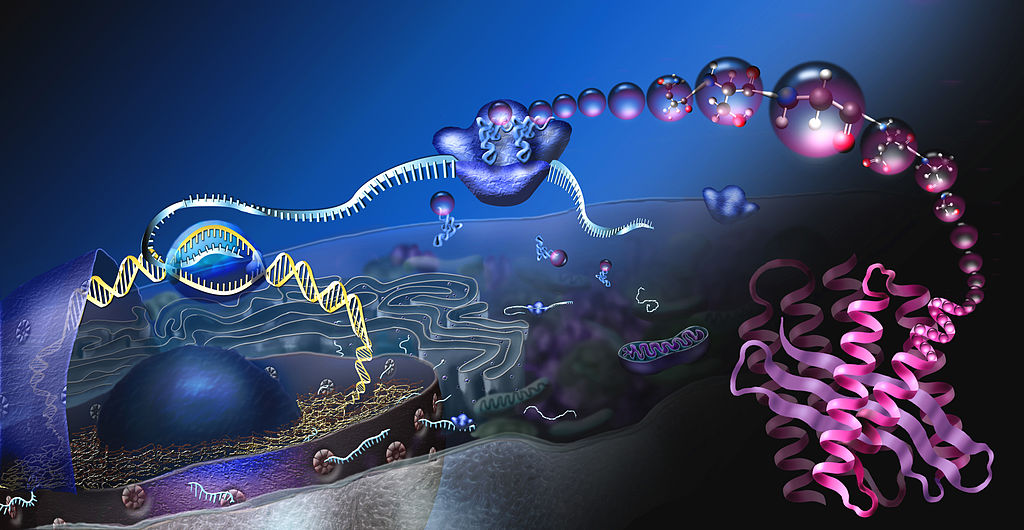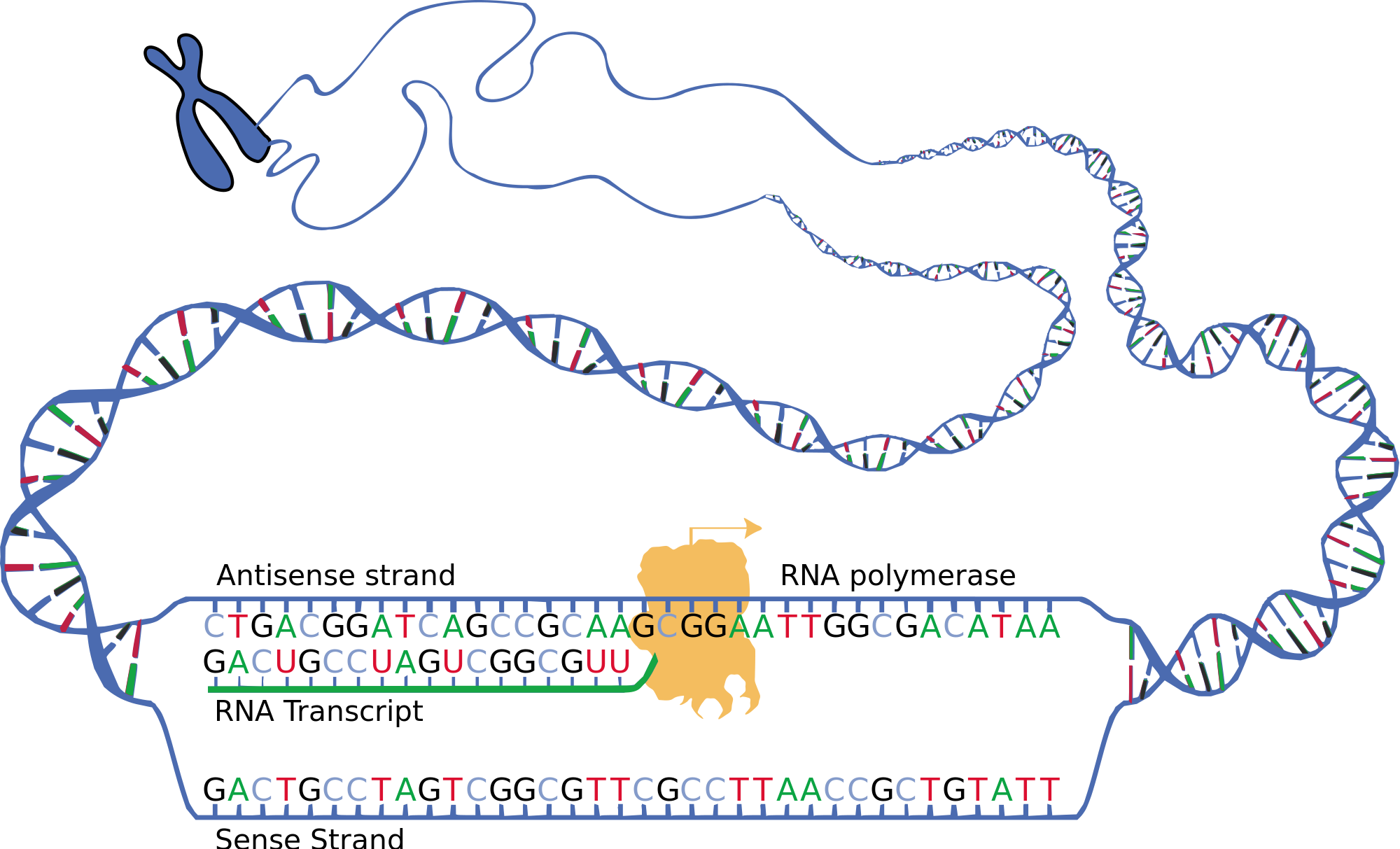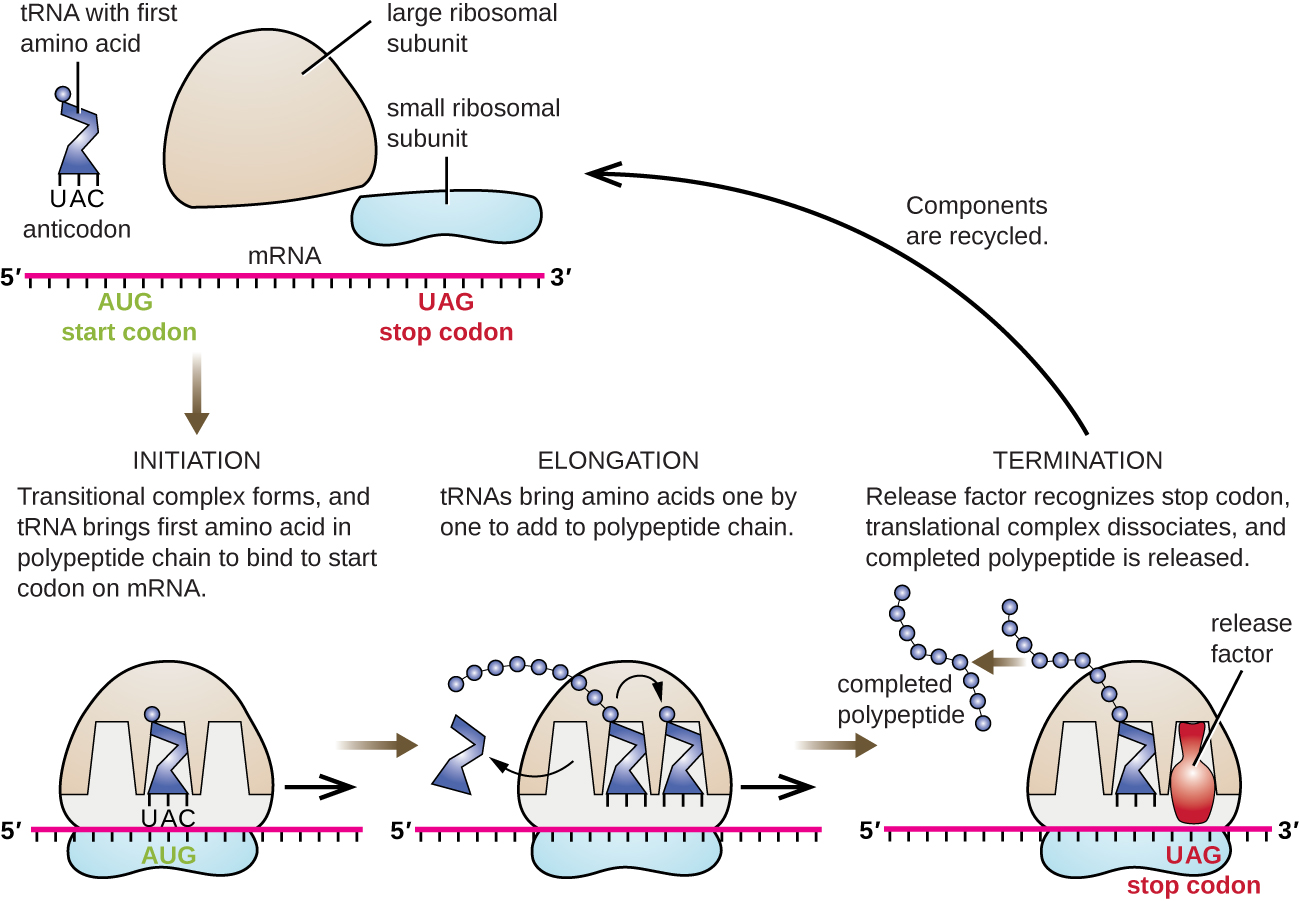Codon Wheel Reading Codons to Make Amino Acids Worksheet Answers
5.7 Protein Synthesis
Created by: CK-12/Adjusted by Christine Miller

The Fine art of Protein Synthesis
This amazing artwork (Effigy five.7.1) shows a process that takes identify in the cells of all living things: the product of proteinsno mail. This procedure is called , and information technologyactually consists of 2 processes — and . In cells, transcription takes place in the . During transcription, is used every bit a template to brand a molecule of messenger RNA (). The molecule of mRNA and then leaves the nucleus and goes to a in the , where translation occurs. During translation, the genetic code in mRNA is read and used to make a polypeptide. These 2 processes are summed up past the central dogma of molecular biological science: → → .
Transcription
Transcription is the first part of the central dogma of molecular biology:Dna → RNA. It is the transfer of genetic instructions in Deoxyribonucleic acid to mRNA. During transcription, a strand of mRNA is made to complement a strand of DNA. You tin can see how this happens in Effigy 5.seven.2.

Transcription begins when the enzyme RNA polymerase binds to a region of a factor chosen the promoter sequence. This signals the Deoxyribonucleic acid to unwind so the enzyme can "read" the bases of Dna. The two strands of DNA are named based on whether they will be used as a template for RNA or not. The strand that is used equally a template is called the template strand, or tin likewise be called the a ntisense strand. The sequence of bases on the opposite strand of Deoxyribonucleic acid is chosen the not-coding or sense strand. Once the DNA has opened, and RNA polymerase has attached, the RNA polymerase moves along the Dna, adding RNA nucleotides to the growing mRNA strand. The template strand of DNA is used every bit to create mRNA through complementary base of operations pairing. Once the mRNA strand is complete, and it detaches from Deoxyribonucleic acid. The effect is a strand of mRNA that is nearly identical to the coding strand DNA – the only difference being that DNA uses the base thymine, and the mRNA uses uracil in the identify of thymine
Processing mRNA
In , the new is non even so prepare for translation. At this phase, it is chosen pre-mRNA, and it must go through more processing before it leaves the nucleus as mature mRNA. The processing may include splicing, editing, and polyadenylation. These processes change the mRNA in various ways. Such modifications permit a single cistron to be used to make more than 1 poly peptide.
- Splicing removes introns from mRNA, as shown in Figure 5.7.iii. Introns are regions that do not code for the protein. The remaining mRNA consists only of regions chosenexons that practise code for the protein. The ribonucleoproteins in the diagram are small proteins in the nucleus that comprise RNA and are needed for the splicing process.
- Editing changes some of the nucleotides in mRNA. For example, a human protein called APOB, which helps transport lipids in the claret, has two different forms because of editing. I form is smaller than the other considering editing adds an earlier stop indicate in mRNA.
- five′ Cappingadds a methylated cap to the "head" of the mRNA. This cap protects the mRNA from breaking downwards, and helps the ribosomes know where to bind to the mRNA
- adds a "tail" to the mRNA. The tail consists of a string of Every bit (adenine bases). It signals the end of mRNA. It is likewise involved in exporting mRNA from the nucleus, and it protects mRNA from enzymes that might break information technology down.

Translation
Translation is the 2nd office of the fundamental dogma of molecular biology:RNA → Protein. It is the process in which the genetic code in is read to make a . Translation is illustrated in Figure 5.vii.iv. Subsequently mRNA leaves the , it moves to a , which consists of rRNA and proteins. The ribosome reads the sequence of in mRNA, and molecules of bring to the ribosome in the correct sequence.
Translation occurs in 3 stages: Initiation, Elongation and Termination.
Initiation:
After transcription in the nucleus, the mRNA exits through a nuclear pore and enters the cytoplasm. At the region on the mRNA containing the methylated cap and the start codon, the small and large subunits of the ribosome bind to the mRNA. These are and then joined by a tRNA which contains the anticodons matching the outset codon on the mRNA. This grouping of molecues (mRNA, ribosome, tRNA) is called an initiation complex.
Elongation:
tRNA go on bringing amino acids to the growing polypeptide according to complementary base pairing between the codons on the mRNA and the anticodons on the tRNA. As a tRNA moves into the ribosome, its amino acrid is transferred to the growing polypeptide. One time this transfer is complete, the tRNA leaves the ribosome, the ribosome moves 1 codon length downwards the mRNA, and a new tRNA enters with its corresponding amino acid. This procedure repeats and the polypeptide grows.
Termination :
At the end of the mRNA coding is a terminate codon which will end the elongation stage. The end codon doesn't telephone call for a tRNA, but instead for a type of protein called a release gene, which will cause the unabridged circuitous (mRNA, ribosome, tRNA, and polypeptide) to pause apart, releasing all of the components.

Watch this video "Protein Synthesis (Updated) with the Amoeba Sisters" to encounter this procedure in action:
Protein Synthesis (Updated), Amoeba Sisters, 2018.
What Happens Next?
Later on a polypeptide chain is synthesized, it may undergo additional processes. For example, information technology may assume a folded shape due to interactions between its amino acids. Information technology may too bind with other polypeptides or with dissimilar types of molecules, such equally or . Many proteins travel to the within the to be modified for the specific job they volition do.7 Summary
- Protein synthesis is the process in which cells make proteins. It occurs in ii stages: transcription and translation.
- Transcription is the transfer of genetic instructions in DNA to mRNA in the nucleus. It includes iii steps: initiation, elongation, and termination. After the mRNA is candy, it carries the instructions to a ribosome in the cytoplasm.
- Translation occurs at the ribosome, which consists of rRNA and proteins. In translation, the instructions in mRNA are read, and tRNA brings the correct sequence of amino acids to the ribosome. So, rRNA helps bonds form between the amino acids, producing a polypeptide chain.
- Afterward a polypeptide chain is synthesized, it may undergo boosted processing to form the finished protein.
- Chronicle protein synthesis and its two major phases to the central dogma of molecular biological science.
- Explain how mRNA is processed earlier it leaves the nucleus.
- What additional processes might a polypeptide chain undergo later on information technology is synthesized?
- Where does transcription take place in eukaryotes?
- Where does translation accept place?
Protein Synthesis, Instructor's Pet, 2014.
Attributions
Figure 5.vii.1
How proteins are made by Nicolle Rager, National Science Foundation on Wikimedia Eatables is released into the public domain (https://en.wikipedia.org/wiki/Public_domain).
Figure 5.7.2
Transcription by National Human Genome Research Plant, (reworked and vectorized by Sulai) on Wikimedia Commons is released into the public domain (https://en.wikipedia.org/wiki/Public_domain).
Effigy 5.vii.iii
Pre mRNA processing past Christine Miller is used nether a CC BY-NC-SA 4.0 (https://creativecommons.org/licenses/past-nc-sa/four.0/) license.
Figure 5.7.four
Translation past CNX OpenStax on Wikimedia Commons is used under a CC By 4.0 (https://creativecommons.org/licenses/by/4.0) license.
References
Amoeba Sisters. (2018, January eighteen) Protein synthesis (Updated). YouTube. https://www.youtube.com/watch?v=oefAI2x2CQM&feature=youtu.be
Parker, N., Schneegurt, 1000., Thi Tu, A-H., Lister, P., Forster, B.Thou. (2016, Nov one). Microbiology [online]. Figure 11.15 Translation in bacteria begins with the germination of the initiation circuitous. In Microbiology (Department 11-4). OpenStax. https://openstax.org/books/microbiology/pages/eleven-iv-protein-synthesis-translation
Teacher's Pet. (2014, December seven). Protein synthesis. YouTube. https://www.youtube.com/watch?five=2zAGAmTkZNY&feature=youtu.be
Source: https://humanbiology.pressbooks.tru.ca/chapter/5-6-protein-synthesis/
0 Response to "Codon Wheel Reading Codons to Make Amino Acids Worksheet Answers"
Post a Comment